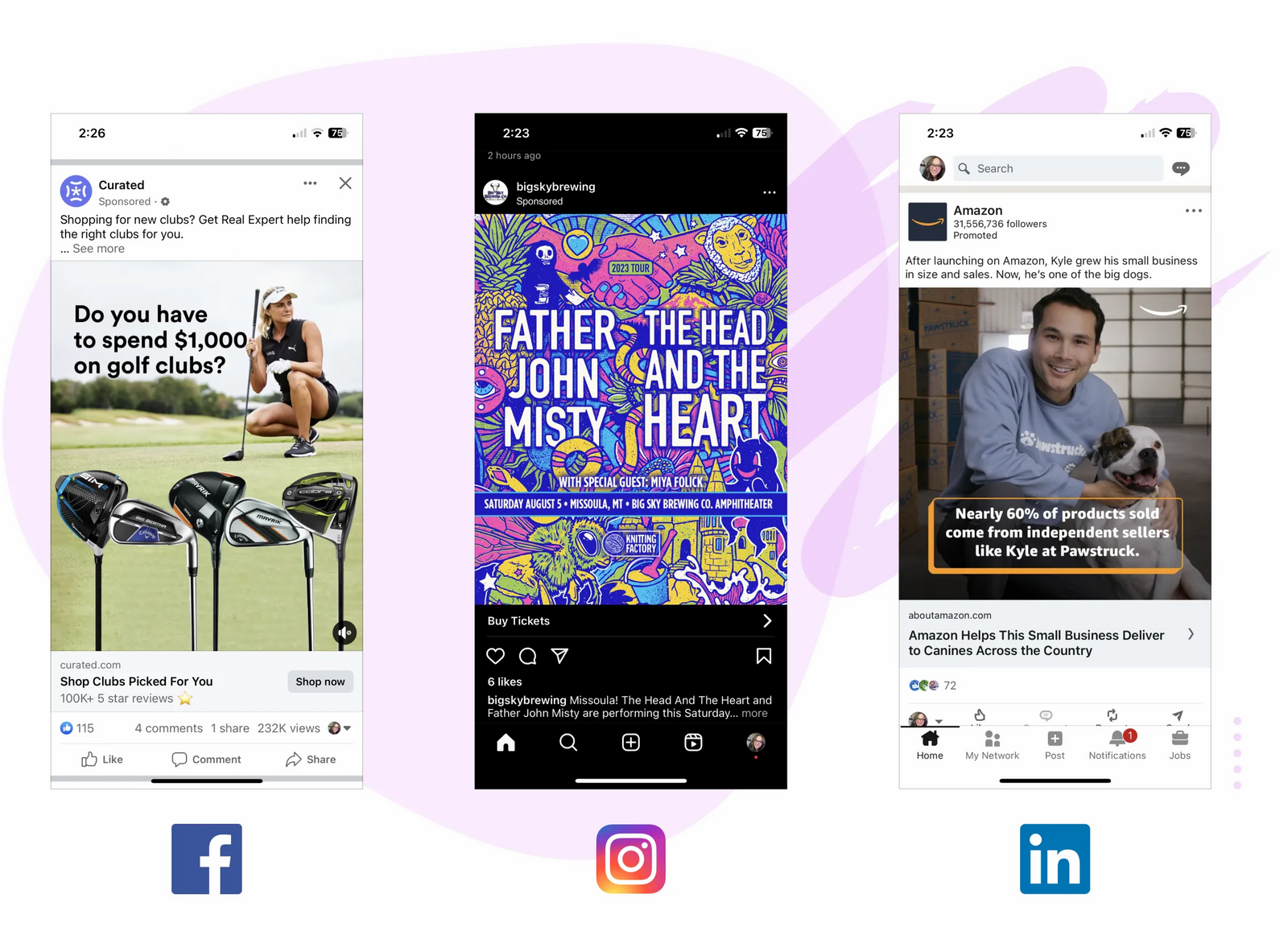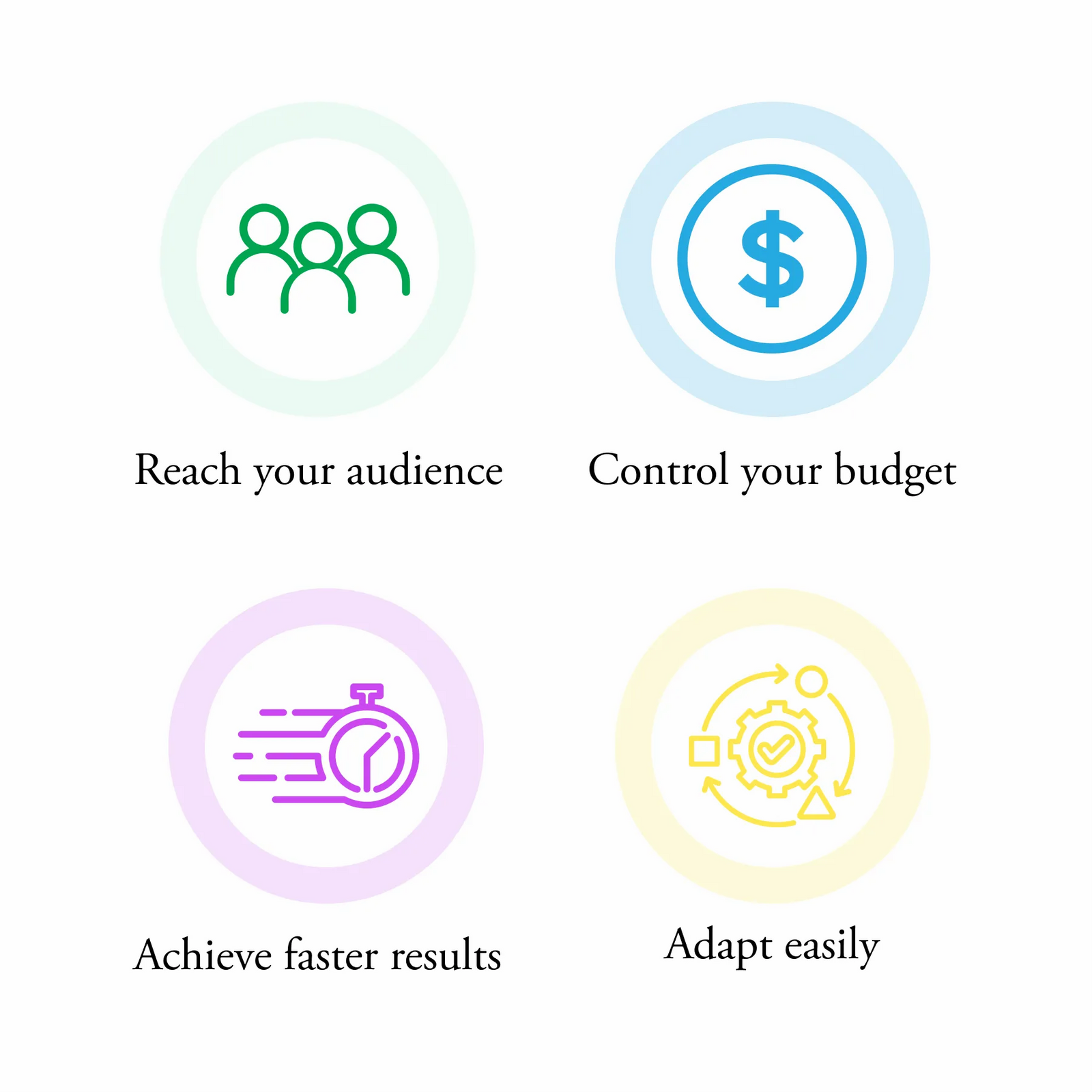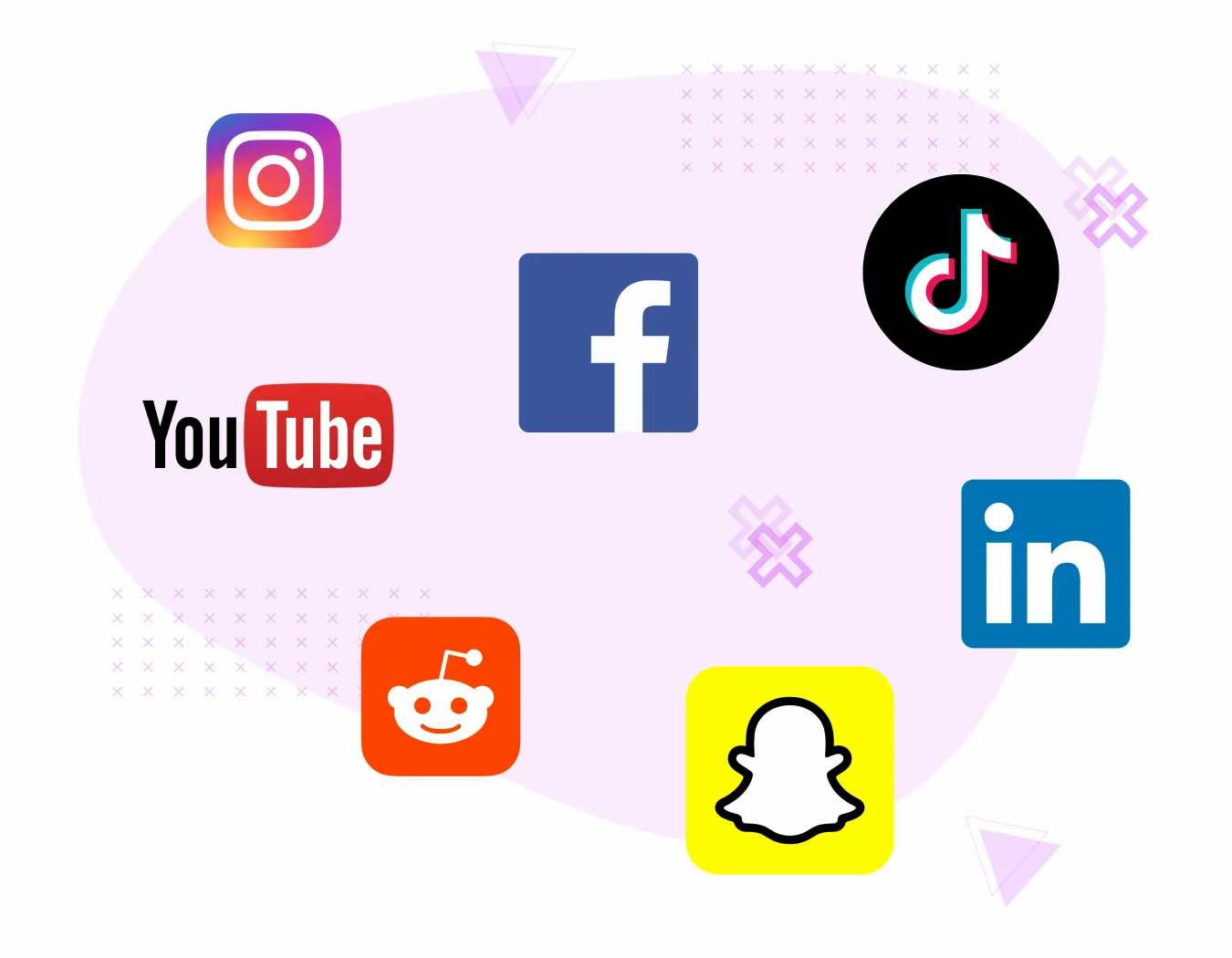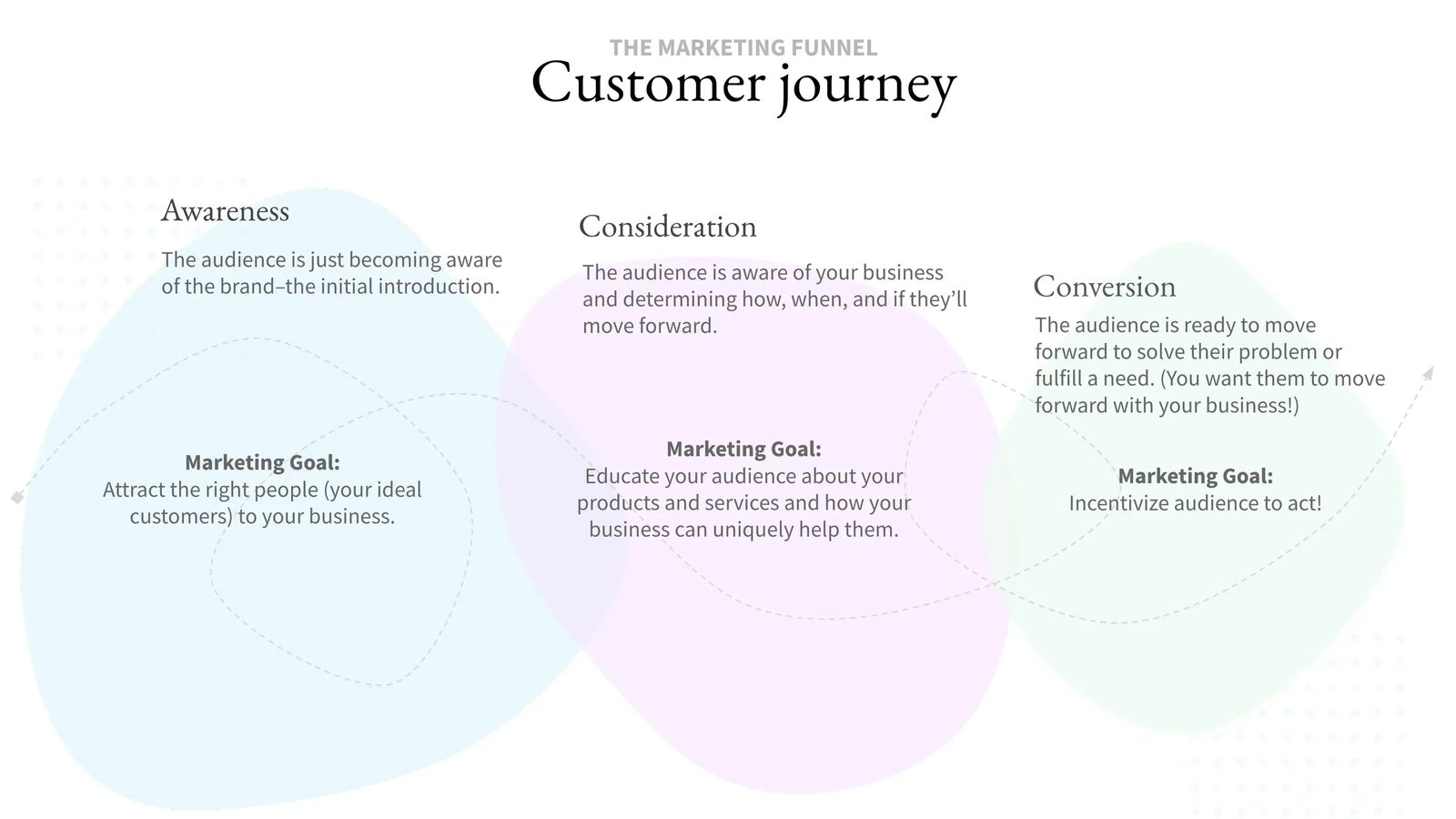
Social media ads – step-by-step guide for beginners
Jessica Baldwin / Published August 3, 2023
These days social media users spend an average of two and a half hours per day using platforms like Facebook, TikTok, LinkedIn, and Instagram. Needless to say, these social channels are an excellent place for your business to connect with potential customers.
Many businesses begin social media marketing by posting organically for free. Organic content is fantastic for building a genuine community around your brand, fostering connections, and engaging with your followers. However, the organic reach of social media posts can be limited, and relying solely on this approach might not achieve your desired reach and impact.
That's where paid social media ads come into play. Social media ad strategies offer opportunities for businesses to maximize their online presence, connect with a highly targeted audience, and drive tangible results. Social media ads are a form of digital marketing that enables you to amplify your message to a larger audience with precision targeting, ensuring that your brand reaches those most likely to be interested in your products or services.
A comprehensive social media strategy will include both organic and paid approaches.
What are social media ads?
Social media ads are a form of online advertising where businesses and individuals promote their products, services, or content on social media platforms. Social media ads often include images, videos, or carousels accompanied by compelling text to engage users and prompt them to take specific actions, such as clicking a link, making a purchase, or signing up for a newsletter.
Ads on social media blend seamlessly with organic content to create a non-disruptive user experience. The goal is to make ads engaging and native to the platform, allowing them to fit in naturally with the content users are accustomed to seeing on their news feeds.

What does social media advertising cost?
The average cost of social media advertising can range from a few cents per click or impression to several dollars, depending on the platform, industry, and the level of targeting and engagement you seek.
The good news is that you have control over your spending. Most platforms let you set a daily budget and start and end dates for your ads so that you can stay within your preferred budget and timeframe. This flexibility empowers you to manage your advertising expenses while reaping the benefits of reaching your target customers online.
The benefits of social media advertising
Social media advertising offers several benefits for businesses of all sizes.

Reach your target audience
Social media channels, including Facebook, Instagram, LinkedIn, Pinterest, X (formerly Twitter), TikTok, Snapchat, Reddit, and YouTube, harness the power of advanced algorithms to optimize ad targeting. These algorithms are designed to ensure your ads reach the right audience – individuals who are highly likely to connect with and engage with your ad's content.
As a result, social media advertising provides businesses with a highly effective and efficient way to engage with their ideal audience, cultivate brand awareness, drive website traffic, and nurture customer relationships. With these intelligent algorithms, you can reach the right people and maximize your advertising investment.
Control your budget
Whether you have a sizable budget or a more modest one, social media platforms cater to businesses of all sizes. You can set your budget per your comfort level, starting at $5 per day on many platforms.
While a lower budget may not deliver impressive results, it does offer valuable opportunities to experiment, learn, and fine-tune your advertising strategy. Starting with a conservative budget allows you to test different ad creatives and refine your target audience before upping your ad spend.
Achieve faster results
Growing a following on social media through organic posts can take significant time. In contrast, advertising on social networks allows you to connect with your target audience immediately.
Whether you want to grow brand awareness, drive website traffic, or generate leads, paid ads with the right targeting and ad design will likely drive quicker results.
Expand your brand visibility
Paid ads can significantly boost brand visibility, especially for startup businesses or those with limited organic reach. When people see your ads regularly while scrolling through their favorite social media sites, they begin to remember your brand more easily.
When people are familiar with your brand, they are more likely to trust it when they need your products or services. Social media advertising can help your brand reach the right audience and build awareness and familiarity.
Easily adapt
One of the incredible advantages of advertising on social media networks is adaptability. Unlike traditional advertising methods that can be rigid and difficult to modify once launched, social media ads offer businesses the flexibility to make changes and adjustments as needed.
You can quickly determine what works and optimize your campaigns. Adjust your ads based on various goals and promotions, ensuring your advertising stays relevant and effective. This flexibility empowers your business to respond swiftly to market changes and achieve better results.
Where to run social media ads
When running social media ads, select the platforms that align best with your business goals and target audience. While you might be tempted to advertise across all platforms, starting with one and expanding from there can be a more practical approach.

Here's a breakdown of popular social media networks and how they can benefit your business:
- Instagram: Ideal for businesses with visually appealing products or services, Instagram's image-centric ad formats allow you to showcase your brand creatively. Leverage Instagram's active user base to engage with consumers and build a visually captivating brand identity.
- Facebook: As the largest social media platform, Facebook offers a wide range of digital advertising targeting options and formats, making it suitable for businesses of all sizes. Reach a diverse audience, engage with potential customers through posts and ads, and build a community around your brand.
- TikTok: If your target audience skews toward a younger demographic, TikTok's short-form videos can be an excellent platform to showcase your brand's fun and creative side. Leverage trending challenges and engaging video ads to capture the attention of Gen Z and millennial users.
- LinkedIn: Ideal for B2B businesses, LinkedIn offers a professional platform to establish thought leadership, network with industry professionals, and promote your products or services to a business-oriented audience.
- X (formerly Twitter): X's fast-paced nature makes it perfect for real-time updates, announcements, and engaging in conversations with your audience. Reach users seeking the latest news and trends while building brand awareness through promoted posts.
- Pinterest: For businesses with visually inspiring content, Pinterest is an excellent choice. Users come to discover and save ideas, making it ideal for showcasing products, DIY projects, recipes, and creative services.
- Snapchat: Catering to a younger, tech-savvy audience, Snapchat's ephemeral content is excellent for building brand awareness and fostering engagement through interactive and playful ads.
- Reddit: Engage with a highly passionate and niche audience on Reddit's various communities (subreddits). If your product or service aligns with specific interests, Reddit can help you target an enthusiastic and tightly-knit community.
- YouTube: As the second-largest search engine after Google, YouTube provides an excellent opportunity for video ads. Leverage its vast user base and various ad formats to engage viewers and showcase your brand story.
When choosing which platform(s) to focus on, consider where your target audience spends their time online. Focus on platforms that align with your brand's personality and content type, ensuring your social media ads reach the right people at the right time.
Key understandings for successful social media advertising
Before you begin a paid social media campaign, it's important to understand a few concepts that will set the foundation for your success.
Tailor your campaign to the marketing funnel
A successful social media advertising campaign recognizes that customers go through different stages before making a purchase. The marketing funnel comprises three key stages: awareness, consideration, and conversion. During the awareness stage, you aim to introduce your brand to a broad audience, creating recognition and interest. In the consideration stage, you focus on nurturing potential customers by providing valuable information and guiding them toward a decision. Finally, in the conversion stage, you want to persuade users to take action and purchase. Understanding this funnel and tailoring your ads accordingly ensures you address your audience's needs at every step of the buyer's journey.

Have patience and persistence for conversions
Customers rarely make immediate purchases after seeing an ad. So, devising a strategy that stays with your audience throughout their decision-making process is crucial. Running just one ad with a relatively low budget may not yield instant results. It's essential to stay committed to your campaign and keep reinforcing your message to maintain brand visibility. Retargeting your audience over time allows you to remind potential customers of your offerings. It increases the likelihood of conversions when they are ready to buy.
Test and optimize
Testing and optimization are paramount in the dynamic world of social media advertising. What works for one campaign might be less effective for another. Regularly testing different ad creatives, messaging, and targeting options helps you identify the most successful combinations. Through continuous optimization, you can maximize your ad performance and get the most out of your advertising budget. Embracing data-driven decisions ensures you continually refine your strategy based on real-time performance data.
Combine social media ads with other marketing tactics
Social media ads are more effective when they are part of a comprehensive marketing strategy. Combine them with a professional website that features engaging content that reflects your brand's personality and offers a seamless user experience. Utilize email marketing to nurture leads and foster customer relationships over time. Posting to social media organically allows you to connect with your audience beyond paid ads, strengthening your brand identity. Encourage online reviews and testimonials to build credibility and trust with potential customers. Reach your audience across the web by combining social media ads with other pay-per-click advertising options like Google Ads. Reach a larger audience and reinforce your messaging across multiple touchpoints.
By understanding the nuances of social media advertising, remaining patient and persistent, testing and optimizing your campaigns, and integrating them into a holistic marketing approach, you can unleash the full potential of social media to achieve your business objectives and connect with your audience on a deeper level.
How to run social media ads
Follow these steps to set up your social ad campaigns.
1) Define your ideal customer
Before diving into social media advertising, it's vital to have a clear understanding of your target audience. Create an ideal customer persona by considering demographics, interests, behaviors, and pain points. The more specific you can be, the better you can tailor your ads to resonate with your intended audience. Conduct market research, analyze customer data, and use social media insights to understand your audience's preferences and habits.
2) Set a goal for your campaign
Establishing a clear goal for your social media campaign is essential. Whether it's increasing website traffic, driving sales, or growing your email list, having a marketing campaign objective will guide your advertising strategy and help you measure success. Each campaign should have a defined Key Performance Indicator (KPI) that aligns with your business objectives. This will allow you to track the campaign's performance and make data-driven decisions to optimize future efforts.
3) Establish an incentive for the audience
Consider offering incentives such as discounts, freebies, or exclusive content to motivate your audience to take action. This will encourage potential customers to engage with your ads and move them closer to conversion. Crafting compelling ad copy that communicates the value of your incentive will capture your audience's attention and pique their interest.
4) Choose the right social platforms
Selecting the appropriate social media platforms ensures you reach your target audience effectively. Consider each platform's demographics and user behavior and choose those that best align with your ideal customer. For example, if your target audience comprises visually-driven consumers, platforms like Instagram and Pinterest may be more suitable, while B2B businesses may find LinkedIn more conducive for lead generation.
5) Install pixels
Installing tracking pixels on your website is crucial for measuring the effectiveness of your social media ads. Each social media ad platform will provide you with a pixel (a snippet of code) that you install on your website. Pixels help you monitor website activity, such as conversions and interactions, providing valuable data for optimizing your campaigns. With pixel data, you can retarget users who have visited your website but haven't completed the desired action, thereby maximizing your chances of conversion.
6) Set up retargeting audiences
Create retargeting audiences based on website visitors and previous interactions with your brand. These audiences are valuable for re-engaging potential customers who have shown interest but haven't converted yet. By showing tailored ads to users who have already engaged with your brand, you can stay top-of-mind and nurture them through the decision-making process.
7) Consider the marketing funnel
Tailor your ads to address your audience's needs at each marketing funnel stage. In the Attention/Awareness stage, you aim to introduce your brand and create interest. Use visually compelling content and concise messaging to capture attention and generate curiosity. During the Consideration stage, provide valuable information, such as blog posts, videos, or product guides, to nurture potential customers. Lastly, in the Conversion stage, present clear calls-to-action and incentives to encourage users to take the desired action, such as making a purchase or signing up for a newsletter.
8) Create ads to appeal to the target audience
Craft ad content that speaks directly to your target audience's pain points and aspirations. Use eye-catching visuals and compelling copy to capture attention and evoke emotions that resonate with your ideal customers. Ensure that the tone and style of your ads align with your brand's personality and messaging to maintain consistency and authenticity.
9) Place ads using the platform's ad manager
Utilize the ad manager provided by each social media platform to create and place your ads. The ad manager allows you to set targeting, budget, and schedule, giving you control over the placement and performance of your campaigns. Utilize A/B testing to experiment with different ad variations and measure which elements drive the best results. Regularly monitor your ad performance, make data-driven optimizations, and refine your strategy to achieve optimal outcomes.
Social media advertising how-to guides
Each social network offers its own advertising platform with individualized campaign setup and optimization recommendations. Follow the links below for guidance on setting up your digital marketing campaigns.
- Facebook Ads Manager
- Instagram Ads for Businesses
- X Business (formerly Twitter Ads)
- LinkedIn Advertising
- Pinterest Ads
- TikTok Ads for Business
- Reddit Advertising
- YouTube Ads
By following these steps, you can unlock social media advertising's potential to connect with your target audience, boost brand awareness, and drive meaningful business results.
Free workbook: Win customers with your website!
Create a strategy to get more leads and sales from your website.







